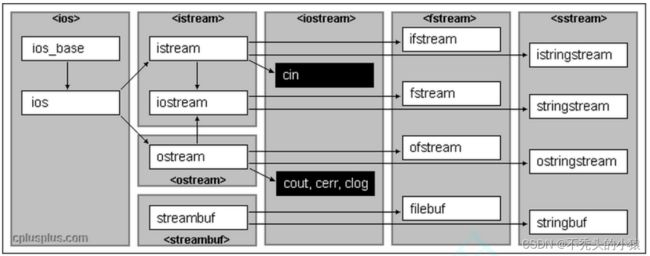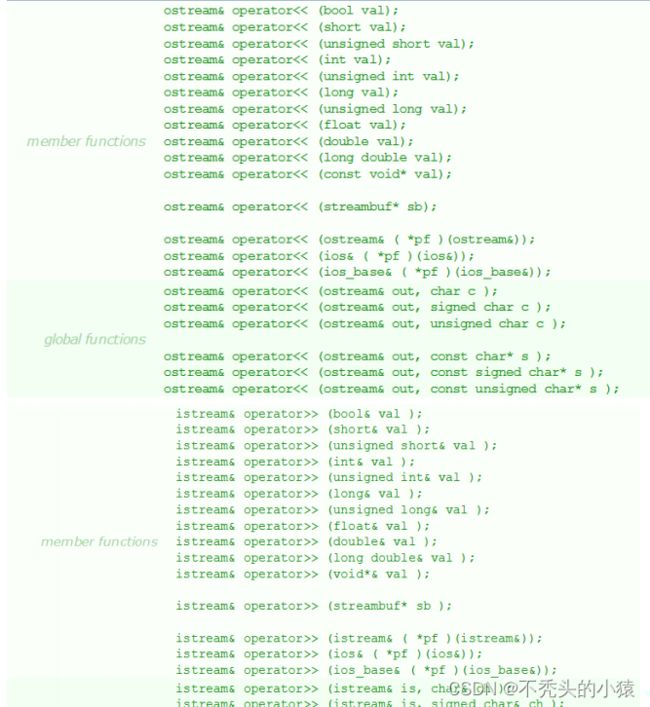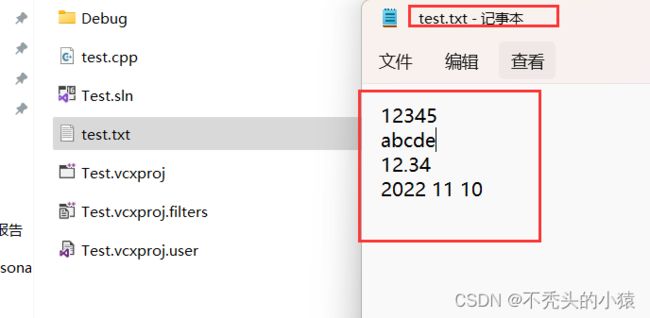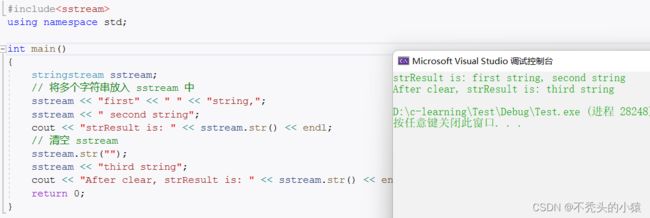C++的IO流
目录
1. 流是什么
2. C++IO流
2.1 C++标准IO流
2.2 C++文件IO流
2.2.1 简单读取文件流
2.2.2 C++读取文件巧妙之处
3. stringstream的简单介绍
1. 流是什么
“流 ” 即是流动的意思,是物质从一处向另一处流动的过程 , 是对一种有序连续且具有方向性的数 据 ( 其单位可以是bit,byte,packet ) 的抽象描述 。
C++流是指信息 从外部输入设备(如键盘)向计算机内部(如内存)输入 和 从内存向外部输出设备(显示器) 输出的过程 。这种输入输出的过程被形象的比喻为“ 流 ” 。
它的特性是:有序连续、具有方向性
为了实现这种流动, C++ 定义了 I/O 标准类库,这些每个类都称为流 / 流类,用以完成某方面的功 能
2. C++IO流
C++系统实现了一个庞大的类库,其中ios为基类,其他类都是直接或间接派生自ios类。
2.1 C++标准IO流
C++标准库提供了 4 个全局流对象 cin 、 cout 、 cerr 、 clog ,使用 cout 进行标准输出,即数据从内 存流向控制台 ( 显示器 ) 。使用 cin 进行标准输入即数据通过键盘输入到程序中 ,同时 C++ 标准库还
提供了 cerr 用来进行标准错误的输出 ,以及 clog 进行日志的输出 ,从上图可以看出, cout, cerr、 clog 是 ostream 类的三个不同的对象,因此这三个对象现在基本没有区别,只是应用场景不同。
在使用时候必须要包含文件并引入std标准命名空间 。
注意:
1. cin为缓冲流。 键盘输入的数据保存在缓冲区中,当要提取时,是从缓冲区中拿 。如果一次输入过多,会留在那儿慢慢用,如果输入错了,必须在回车之前修改,如果回车键按下就无法
挽回了 。 只有把输入缓冲区中的数据取完后,才要求输入新的数据 。
2. 输入的数据类型必须与要提取的数据类型一致 ,否则出错。
3. 空格和回车都可以作为数据之间的分格符,所以多个数据可以在一行输入,也可以分行输
入。但如果是 字符型和字符串,则空格( ASCII 码为 32 )无法用 cin 输入,字符串中也不能有空 格 。回车符也无法读入。
4. cin和 cout 可以直接输入和输出内置类型数据,原因: 标准库已经将所有内置类型的输入和
5. 对于自定义类型,如果要支持cin和cout的标准输入输出,需要对<<和>>进行重载 。
举例:
class Date
{
friend ostream& operator << (ostream& out, const Date& d);
friend istream& operator >> (istream& in, Date& d);
public:
Date(int year = 1, int month = 1, int day = 1)
:_year(year)
, _month(month)
, _day(day)
{}
operator bool()
{
// 这里是随意写的,假设输入_year为0,则结束
if (_year == 0)
return false;
else
return true;
}
private:
int _year;
int _month;
int _day;
};
istream& operator >> (istream& in, Date& d)
{
in >> d._year >> d._month >> d._day;
return in;
}
ostream& operator << (ostream& out, const Date& d)
{
out << d._year << " " << d._month << " " << d._day;
return out;
} 6. istream类型对象转换为逻辑条件判断值:
istream& operator>> (int& val);
explicit operator bool() const; 实际上我们看到使用while(cin>>i)去流中提取对象数据时,调用的是operator>>,返回值是
istream类型的对象,那么这里可以做逻辑条件值,源自于istream的对象又调用了operator
bool,operator bool调用时如果接收流失败,或者有结束标志,则返回false。
2.2 C++文件IO流
C++根据文件内容的数据格式分为 二进制文件 和 文本文件 。采用文件流对象操作文件的一般步
骤:
1. 定义一个文件流对象
ifstream ififile(只输入用)
ofstream ofifile(只输出用 )
fstream iofifile(既输入又输出用 )
2. 使用文件流对象的成员函数打开一个磁盘文件 ,使得文件流对象和磁盘文件之间建立联系
3. 使用提取和插入运算符对文件进行读写操作,或使用成员函数进行读写
4. 关闭文件
2.2.1 简单读取文件流
2.2.2 C++读取文件巧妙之处
如果仅仅是为了实现上图的文件读取,C语言也很容易做到,那么C++为什么要引入IO流呢?
实际上,C++文件流的优势就是可以对内置类型和自定义类型,都使用一样的方式,去流插入和流提取数据,当然这里自定义类型需要重载>> 和 <<。
举个例子:
再展示一个比较有意思的用例了解二进制读写和文本读写:
class Date{...};
istream& operator >> (istream& in, Date& d){...}
ostream& operator << (ostream& out, const Date& d){...}
struct ServerInfo
{
//char _address[32];
string _address;
int _port;
Date _date;
};
// 二进制读写:在内存如何存储,就如何写到磁盘文件
// 优点:快 缺点:写出去内容看不见
// 文本读写:对象数据序列化字符串写出来,读回来也是字符串,反序列化转成对象数据
// 优点:可以看见写出去是什么 缺点:存在一个转换过程,要慢一些
struct ConfigManager
{
public:
ConfigManager(const char* filename = "server.config")
:_filename(filename)
{}
//二进制写
void WriteBin(const ServerInfo& info)
{
ofstream ofs(_filename, ios_base::out | ios_base::binary);
ofs.write((char*)&info, sizeof(info));
}
//二进制读
void ReadBin(ServerInfo& info)
{
ifstream ifs(_filename, ios_base::in | ios_base::binary);
ifs.read((char*)&info, sizeof(info));
}
//文本写
void WriteText(const ServerInfo& info)
{
ofstream ofs(_filename, ios_base::out);
ofs << info._address << endl;
ofs << info._port << endl;
ofs << info._date << endl;
}
//文本读
void ReadText(ServerInfo& info)
{
ifstream ifs(_filename, ios_base::in);
ifs >> info._address >> info._port >> info._date;
}
private:
string _filename; // 配置文件
};
int main()
{
//二进制写出去
ServerInfo winfo = { "127.0.0.1", 888 };
ServerInfo winfo = { "https://legacy.cplusplus.com/reference/istream/istream/read/", 888, { 2022, 11, 30 } };
ConfigManager cm;
cm.WriteBin(winfo);
// 二进制的读
ServerInfo rinfo;
ConfigManager cm;
cm.ReadBin(rinfo);
cout << rinfo._address << endl;
cout << rinfo._port << endl;
//文本写出去
ServerInfo winfo = { "127.0.0.1", 888};
ServerInfo winfo = { "https://legacy.cplusplus.com/reference/istream/istream/read/", 888, { 2022, 11, 30 } };
ConfigManager cm;
cm.WriteText(winfo);
// 文本的读
ServerInfo rinfo;
ConfigManager cm;
cm.ReadText(rinfo);
cout << rinfo._address << endl;
cout << rinfo._port << endl;
cout << rinfo._date << endl;
return 0;
}3. stringstream的简单介绍
在 C 语言中,如果想要将一个整形变量的数据转化为字符串格式,如何去做?
1. 使用 itoa() 函数
2. 使用 sprintf() 函数
但是两个函数在转化时,都得 需要先给出保存结果的空间 ,那空间要给多大呢,就不太好界定,
而且 转化格式不匹配时,可能还会得到错误的结果甚至程序崩溃 。
在C++中,可以使用stringstream类对象来避开此问题。
1. 字符串拼接
int main()
{
stringstream sstream;
// 将多个字符串放入 sstream 中
sstream << "first" << " " << "string,";
sstream << " second string";
cout << "strResult is: " << sstream.str() << endl;
// 清空 sstream
sstream.str("");
sstream << "third string";
cout << "After clear, strResult is: " << sstream.str() << endl;
return 0;
}2. 序列化和反序列化结构数据
struct ChatInfo
{
string _name; // 名字
int _id; // id
Date _date; // 时间
string _msg; // 聊天信息
};
int main()
{
// 序列化
ChatInfo winfo = { "张三", 135246, { 2022, 4, 10 }, "晚上一起看电影吧" };
//ostringstream oss;
stringstream oss;
oss << winfo._name << endl;
oss << winfo._id << endl;
oss << winfo._date << endl;
oss << winfo._msg << endl;
string str = oss.str();
cout << str << endl;
// 反序列化
ChatInfo rInfo;
//istringstream iss(str);
stringstream iss(str);
iss >> rInfo._name;
iss >> rInfo._id;
iss >> rInfo._date;
iss >> rInfo._msg;
cout << "----------------------------------" << endl;
cout << rInfo._date << endl;
cout << rInfo._name << "[" << rInfo._id << "]:>" << rInfo._msg << endl;
cout << "----------------------------------" << endl;
return 0;
}





